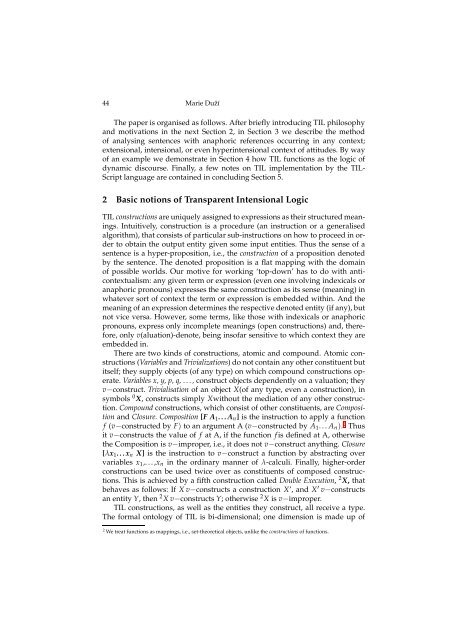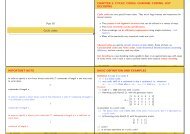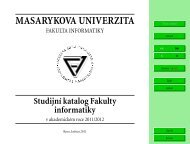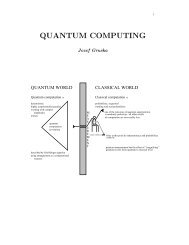Semantic Pre-processing of Anaphoric References
Semantic Pre-processing of Anaphoric References
Semantic Pre-processing of Anaphoric References
You also want an ePaper? Increase the reach of your titles
YUMPU automatically turns print PDFs into web optimized ePapers that Google loves.
44 Marie Duží<br />
The paper is organised as follows. After briefly introducing TIL philosophy<br />
and motivations in the next Section 2, in Section 3 we describe the method<br />
<strong>of</strong> analysing sentences with anaphoric references occurring in any context;<br />
extensional, intensional, or even hyperintensional context <strong>of</strong> attitudes. By way<br />
<strong>of</strong> an example we demonstrate in Section 4 how TIL functions as the logic <strong>of</strong><br />
dynamic discourse. Finally, a few notes on TIL implementation by the TIL-<br />
Script language are contained in concluding Section 5.<br />
2 Basic notions <strong>of</strong> Transparent Intensional Logic<br />
TIL constructions are uniquely assigned to expressions as their structured meanings.<br />
Intuitively, construction is a procedure (an instruction or a generalised<br />
algorithm), that consists <strong>of</strong> particular sub-instructions on how to proceed in order<br />
to obtain the output entity given some input entities. Thus the sense <strong>of</strong> a<br />
sentence is a hyper-proposition, i.e., the construction <strong>of</strong> a proposition denoted<br />
by the sentence. The denoted proposition is a flat mapping with the domain<br />
<strong>of</strong> possible worlds. Our motive for working ‘top-down’ has to do with anticontextualism:<br />
any given term or expression (even one involving indexicals or<br />
anaphoric pronouns) expresses the same construction as its sense (meaning) in<br />
whatever sort <strong>of</strong> context the term or expression is embedded within. And the<br />
meaning <strong>of</strong> an expression determines the respective denoted entity (if any), but<br />
not vice versa. However, some terms, like those with indexicals or anaphoric<br />
pronouns, express only incomplete meanings (open constructions) and, therefore,<br />
only v(aluation)-denote, being ins<strong>of</strong>ar sensitive to which context they are<br />
embedded in.<br />
There are two kinds <strong>of</strong> constructions, atomic and compound. Atomic constructions<br />
(Variables and Trivializations) do not contain any other constituent but<br />
itself; they supply objects (<strong>of</strong> any type) on which compound constructions operate.<br />
Variables x, y, p, q, . . . , construct objects dependently on a valuation; they<br />
v−construct. Trivialisation <strong>of</strong> an object X(<strong>of</strong> any type, even a construction), in<br />
symbols 0 X, constructs simply Xwithout the mediation <strong>of</strong> any other construction.<br />
Compound constructions, which consist <strong>of</strong> other constituents, are Composition<br />
and Closure. Composition [F A 1 . . . A n ] is the instruction to apply a function<br />
f (v−constructed by F) to an argument A (v−constructed by A 1 . . . A n ). 2 Thus<br />
it v−constructs the value <strong>of</strong> f at A, if the function f is defined at A, otherwise<br />
the Composition is v−improper, i.e., it does not v−construct anything. Closure<br />
[λx 1 . . . x n X] is the instruction to v−construct a function by abstracting over<br />
variables x 1 ,. . . ,x n in the ordinary manner <strong>of</strong> λ-calculi. Finally, higher-order<br />
constructions can be used twice over as constituents <strong>of</strong> composed constructions.<br />
This is achieved by a fifth construction called Double Execution, 2 X, that<br />
behaves as follows: If X v−constructs a construction X’, and X ′ v−constructs<br />
an entity Y, then 2 X v−constructs Y; otherwise 2 X is v−improper.<br />
TIL constructions, as well as the entities they construct, all receive a type.<br />
The formal ontology <strong>of</strong> TIL is bi-dimensional; one dimension is made up <strong>of</strong><br />
2 We treat functions as mappings, i.e., set-theoretical objects, unlike the constructions <strong>of</strong> functions.















